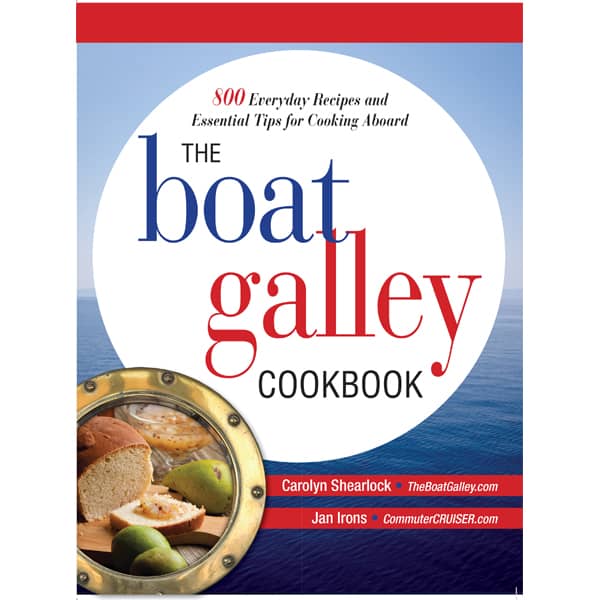
Meat can be one of the trickiest foods to store aboard a boat. Meat that’s not stored properly can cause food poisoning (definitely NOT a good thing no matter where you are) and fear of food poisoning can cause you to throw any suspicious meat away. Here are a number of important things that I learned for safely storing fresh meat aboard a cruising boat.
NOTE: In this article, I assume that you have a working refrigerator on your boat. If you have an ice box or cooler, you cannot store fresh meat longer than a few hours (commercially vacuum sealed and frozen meat can last a few days in a cooler) and should consider using canned meat. It’s possible to make great meals with canned meats, without worrying about storage.
I also assume that you’ve taken precautions to keep the meat cold on the way from the store to the boat. In some places, this isn’t hard as the climate isn’t that hot and the distance not that far. But when we were in El Salvador, for example, temperatures were generally 90+ and it was over an hour by taxi from the supermarket to the dinghy dock. We took a good-sized cooler with us and bought a bag of ice to pack the meat and other perishables in. (See my choice for a great soft sided provisioning cooler.)
Requirements for Storing Meat
According to Purdue University Animal Sciences, refrigerated meat should be stored below 40 degrees Farenheit, ideally below 35, to prevent bacteria growth that can cause food poisoning. Even at that temperature, it should be used within 4 days.
This leads to several points:
- Many boat refrigerators don’t have an area that is consistently below 35 degrees — Que Tal’s didn’t.
- Even if there is an area below 35, most meat is going to have to be frozen, since few cruisers have access to grocery stores every four days.
- Most boat freezers are tiny compared to house refrigerators — for example, ‘s Alder Barbour Super Cold Machine had less than 4/10 of a cubic foot of freezer space, compared to 4 cubic feet in an 18 cubic foot refrigerator (which is on the small side for a home refrigerator).
Strategy for Storing Meat on a Boat
So, it boils down to using the available space as efficiently as possible. Here is my strategy:
- Whenever possible, I’d buy some meat that was vacuum-packaged at the manufacturer (such as bacon, hot dogs, smoked sausage and lunch meat). Such meat packages can be kept unopened in a cold part of the refrigerator officially up to 2 weeks — I actually kept it a month or more several times but if you do, it’s at your own risk. I stored these in a bin right below the freezer compartment — the coldest place in my refrigerator outside the freezer.
- Other meats I either bought boneless or I boned it before freezing it — if you have a tiny freezer, you just can’t give space to inedible things like bones and extra packaging. Read about boning chicken breasts.
- I re-packaged meats before they went into the freezer to get rid of bulky packaging. I divided meat into portions that would feed two people for one meal, and then either vacuum sealed each portion or put it in a freezer Ziploc and tried to get all the air out before sealing the bag.
- We ate smaller portions of meat than we had when living ashore — I’d make a quarter pound of ground beef or one chicken breast serve two of us for dinner. This almost doubled the number of “meals” that I could put in the freezer and was healthier as well.
- Be sure to label the packages — it’s very hard to tell cuts apart when frozen!
- Mix up the types of meat as you put them in the freezer. You don’t want all the hamburger on the bottom, so that you have to take everything else out when you want a package — and then try to re-pack all the frozen blobs so they all fit!
- Extend your meat supply with canned meats. See my tips on using canned meats to make great meals without the dreaded “canned meat mush.”
- Rarely, one of my Ziplocs would develop a tiny tear and the meat inside would get a little freezer burned. I quickly learned that while it was no longer good for “quick cooking” techniques like grilling and sauteing, it was still fine to eat if I used a long, slow, moist cooking technique such as pan roasting.
- Fresh fish and other seafood are other good ways to extend your meat supply — either catching it yourself or buying from the local fishermen.
Bottom Line
While we could buy fresh produce and some other staples in even the tiniest villages, I didn’t want to buy meat there. But so many of our favorite anchorages were a day or two away from any “real” supermarkets. By following these meat storage tips, I could easily go one to two months before having to re-stock my meat supply. And that gave us a lot more time in gorgeous places!
Read Next:

Carolyn Shearlock has lived aboard full-time for 17 years, splitting her time between a Tayana 37 monohull and a Gemini 105 catamaran. She’s cruised over 14,000 miles, from Pacific Mexico and Central America to Florida and the Bahamas, gaining firsthand experience with the joys and challenges of life on the water.
Through The Boat Galley, Carolyn has helped thousands of people explore, prepare for, and enjoy life afloat. She shares her expertise as an instructor at Cruisers University, in leading boating publications, and through her bestselling book, The Boat Galley Cookbook. She is passionate about helping others embark on their liveaboard journey—making life on the water simpler, safer, and more enjoyable.
Simplify meal prep on board with proven strategies for provisioning, maximizing fridge space, and cooking delicious meals aboard your boat.










Victor says
There are other alternatives to meat storage that have not been taken into account .. there are 4 options that come immediately to mind ..
1) Smoked
2) dried ( salted )
3) Bottled ( like preserves )
4)Jerked … ( which can also be used as a basis for making pemmican )and when it’s made into pemmican , it can last for years …
With the exception of number 3, all these meat options have considerably reduced weight, can be stored for extended periods of time without serious difficulty and can be used as a basis for other meals ( like stews or chili ) … Just a Thought about other options ;))
Mary Dixon says
A problem with most packaged meats is their high sodium content, which is unhealthy for many people. We use an Engel freezer http://www.engel-usa.com/ that is very energy efficient that runs on both 110 or 12V to freeze fresh meat. You can buy this from a variety of places, so best to price shop.
Blue Water Dreaming on Facebook says
Great article! We’ve been living on our boat now at the marina for just over two months and are fortunate enough to have a 20l on board eutectic fridge as well as a waeco fridge/freezer (depending on the temp you set it). I have so many questions about adjusting to a boat galley, storing foods effectively and cruising life in geneal, your informative website goes a long way to answering them. Thank you!
Janice Fleischmann says
I invested in a Seal-a-Meal vacuum bagger (I do have a decent size freezer on our 38′ sailboat though) and have kept meat for a couple of months with no freezer burn or spoilage. I have coloured mesh bags ( purchased at the dollar store or West Marine) to keep my meat sorted – pink for chicken, blue for beef, yellow for sausage type meats, etc. It is very easy to pull the bag out of the `bottomless pit` of a freezer and nothing gets missed.
George Petrolekas says
An suggestion for meat storage…..when we were cruising, we had a very very insulated icebox. For steaks, we’d buy an entire sirloin strip and freeze it solid. When planning for the next days steaks, we’d take out a saw, and saw the large frozen sirloin into the size steaks we’d want for that evening and let them thaw. Having a large piece of beef frozen kept longer than individual steaks that were put in the icebox. The only other thing we did was extensive meal planning and so meals were layered by day. There was no digging down for something, (except for the sirloin 🙂 )
Sue Norris says
We have been told by our butcher that cryovac meat will last over a month in the coolest part of the fridge. We have kept meat that long and never had any problems. Chicken I keep for no more than 2 weeks. Fish 10 days. We have a vacuum packer on the boat and it works well for sealing dry goods as well as meat. We have lived in latitudes between 40 deg south and the tropics and lived aboard for 8 years.
Bob Bechler says
We take very long passages and found that canning chicken before we left really stretches storage
John Ahern says
I always bring my meats frozen onto the boat and that will add to the shelf life. I know it is easy when you take from your home to do that! Even on longer passages that I buy from a store away from my home base, I ask them to freeze the meats for me and I pick up the next day. Most stores will do that for you if you explain why.
Terry Simmons says
You can also buy tuna, chicken, corned beef in foil bags. They weigh less than the cans too.
Evan C. Myers says
Fantastic information,
thank you for sharing!
Eric Hendricks says
you cannot take raw meat into Mexico. Frozen or not.
The Boat Galley says
Which side are you on? Caribbean or Pacific? Last I’d heard from those on Pacific side, taking raw meat was not a problem. Things may have changed, but I see that the 2015 Baja Ha-Ha’s First Timer’s Guide to Mexico makes no mention of it. https://www.baja-haha.com/Guide/MexFTG-2015.pdf
Eric Hendricks says
Caribbean side.
Carolyn Shearlock says
That might be the difference.
Randi Barry says
Weird! We went on the Caribbean side of Mexico on a Superyacht full of all sorts of raw meat and it was no problem at all. The strictest place we went was Galapagos and they made us hull strawberries and toss oranges that was the worst of it.
Stephanie Hamilton says
Go. To. Cuba. Food. Vintage cars. Music. etc etc etc.
Pamela Douglas Webster says
I’d also encourage meat eaters to explore meat-free options too.
After all, cruisers are adventurous people. And should love trying new things. 🙂
Mike McCollough says
What is the shelf life of Brinkmans?
Carolyn Shearlock says
Canned meat can be kept at least 2 years, generally 5 years, with no degradation in quality. It is still “good” (as in, won’t harm you but the taste and texture may not be as good) after that.
Fran says
I have a small refrigerater and no freezer.You can get pretty good dried meat at most camping / sporting good stores. Sometimes pricey but its not the whole meal. I extend my meat meals with canned beans, vegies and chopped up eggplant is great. My husband was eating eggplant / meat for years before he figured it out.Its all in the seasoning. And its healthier for you.We ve lived aboard mostly outside the states for 35 years .S / V “AKA” currently Opua New Zealand